| |
“I didn’t make this movie for it to be scary. When I watch horror – and I watch four horror movies a week – I am searching for one that is going to really scare me. I want to be scared, to jump out of my seat and yell. But I did not make this movie like that. I didn’t use jump scares. You are disturbed, that’s my aim. To shake you to the core.” |
| |
Director Julia Ducounau interviewed in The Independent* |
Raw [Grave] opens in the manner of many a modern horror film, yet at the same time not quite like any of them. On a quiet but open and straight country road, a figure can be seen walking by the roadside in a shot framed so wide that you might not even notice it if you were watching the film on a tablet or a phone. You’re not, are you? The camera then switches to the opposite viewpoint, still in expansive wide shot, to reveal that a car is approaching this spot. We then return to the first shot and the walking figure is no longer visible, but just as the car enters frame, the figure suddenly runs out into the road, which causes the vehicle to swerve and barrel into the trunk of a roadside tree. A closeup of the crumpled front of the car reveals no movement, suggesting that the driver has been killed or seriously injured. When we once again return to that opening wide shot, the figure that caused the accident can be seen lying in the road, but then it gets up, dusts itself off, walks calmly to the stationary vehicle and peers in through the window as an unsettling, off-key musical whine builds on the soundtrack. Cue opening title. It’s an opening sequence of the sort that genre fans should be familiar with, one in which we’re given an early glimpse of a later horror to come. Here, however, not only is it unclear precisely what we have just witnessed, but also how it could possibly connect with the story that subsequently unfolds. Indeed, on my first viewing of Julia Ducournau’s extraordinary debut feature back in 2017, so quickly engrossed did I subsequently become in the story and characters that this sequence slipped my mind until its aftermath is witnessed by the lead character through the window of a bus on which she is travelling.
So what’s the story here? Justine (Garance Marillier) is in her late teens and has enrolled in the same veterinary school that her father (Laurent Lucas) and mother (Joana Preiss) attended and where her older sister Alex (Ella Rumpf) is already a student. I should point out that none of this is explicitly spelt out and that we deduce it from the manner in which the opening scenes play out. Justine is being driven to the school by her parents, and as the film proper begins, they’ve stopped off for food at a roadside café, where Justine’s polite request for mashed potato sees a dollop of the stuff slapped unceremoniously on her plate. “No protein?” the server cheerlessly asks, to which Justine replies, “No thanks. No meat.” When she takes a mouthful of the potato, however, she reacts with alarm and spits out a meatball that was buried within. Her mother checks urgently to confirm she did not bite into it, then angrily returns the food to the counter and berates the server, despite Justine’s pleads to just let it go. It’s a simple scene in which a couple of key things are economically established, with Justine’s vegetarianism confirmed along with the strong suggestion that this was not a personal choice but one forced on her by her strictly vegetarian parents. Only on a second viewing did the full implications of this sequence really hit home.

As they arrive at the school, Alex fails to show up to meet them as promised and we learn a bit more about her bumpy relationship with her parents, particularly when her mother asks Justine to phone her because, “She may answer for you.” With Alex not answering the parents depart, leaving Justine to make her way to her assigned living quarters, but she’s only just bedded down for the night when she is woken by outside pandemonium and her new gay roommate Adrien (Rabah Nait Oufella) bursting into her room. He’s quickly followed by a gang of masked and rambunctious students, who tear the place apart, throw bedding though the windows and push Justine and Adrien into the corridor with all the other freshmen in what we soon discover is the first stage of a week-long hazing ritual.
Ah yes, hazing. I’ve already said my piece on this peculiar slice of educational power play in my review of Jack Garfein’s The Strange One, and if there’s even a whiff of truth to the unpleasantries inflicted on the students here, it’s hardly surprising that the practice was banned in France in 2018, though reports have suggested that some universities are still turning a blind eye to it. Here, the confused new students, all still dressed in their nightclothes, are forced to crawl along a darkly lit basement floor (a surreally spooky sequence that also takes on secondary meaning on subsequent viewings), and end up in the pulsating throng of dance floor in what is effectively a welcome party. It’s here that Justine finally meets up with Alex, and it’s clear that despite their personality differences, deep down the two are close. Quite how close is tested the following day, when the next stage of the hazing sees the new students soaked in animal blood and forced to eat a piece of what one students describes as, “rabbit kidney – best not to know.” Justine protests that as a vegetarian she can’t eat meat, but this cuts no ice. When she appeals to Alex to back her up, her sister mocks her stance and effectively force feeds her the kidney piece. That night Justine is woken by a terrible itching, and when she switches on the light she discovers that her skin is now covered in an appalling rash. When she visits the campus medical facility the following day, she is told by the attending nurse (Marion Vernoux) that this is an allergic reaction and is given some cream to help ease it, but this proves to be just the start of her problems.
Just how much to reveal about what happens next is a difficult call. It’s always good if you can approach any film with little knowledge of its content or reputation, but given that most of the discussion about this one revolves around where eating that little bit of rabbit kidney eventually leads Justine, that’s going to be something of a tall order here. Adding to the problem is that if you were somehow able to go in cold, then there is just a chance that you’ll regret doing so. Raw is not an all-out horror film, but the early blend of drama and more light-hearted character moments eventually give way to the sort of body horror that will have some viewers running for the proverbial exit. This aspect is also something that I need to get into if I’m going to discuss what makes this film so special (and it absolutely is), so if you’ve somehow managed to avoid reading anything about where the film later heads and want to keep it that way, then I’d quit reading now, as even the play-on-words titles of some of the special features could also technically count as potential spoilers. So, yes, watch out, as there are going to be spoilers ahead, though I will dance around some of the major reveals and certainly won’t be giving away the ending.

If you have read anything about Raw then you’ll likely be aware that the horror at its heart is one of cinema’s last remaining taboos, and despite having been featured in a number of previous films and a certain celebrated television series, the whole notion of cannibalism is still one with the potential to trigger an immediate and very negative reaction. It’s hardly surprising. Take, for example, the notion that a person might stop eating meat because of feelings they might have about the animals from which this food has been sourced and then replace that animal with a friend or loved one and there’s a chance we’d all turn vegetarian overnight. It’s also more than a purely moral decision, if you consider the instinctive reaction most of us have when confronted with the body that has been badly injured or mutilated. Confronted in the real world with the sight of someone feeding off the flesh of another, I’m fairly sure that most people’s immediate reaction would be horrified revulsion. This notion that you could become a meal for others of your species lies at the heart of Ruggero Deodato’s notorious Cannibal Holocaust, and became the defining characteristic of Hannibal Lector, perhaps the most famous fictional serial killer of the modern age. In films, cannibalism is almost always presented as a mark of the beast, abhorrent behaviour that defines a character as monstrous by default. Rarely are its origins explored or reasons given for why someone would turn to cannibalism in the first place, notable exceptions being Frank Marshall’s 1993 Alive and Rene Cardona's less reputable 1976 Survive!, both of which were based on the true story of the members of a Uruguayan rugby team who survived a plane crash in the alps and avoided starvation by eating the flesh of their dead compatriots.
In Raw, Justine initially appears to be drawn to the dark side by something as trivial as a small piece of rabbit kidney. It first provokes an extreme allergic reaction, then triggers in her an increasingly uncontrollable desire to eat meat, which we can presume from the strictly vegetarian beliefs of her parents is a new experience for her. It’s a desire so out of character that she initially tries to conceal it, stealing a burger in the canteen that she discards when challenged, then accompanying Adrien to a truck stop for a meat-filled baguette that she is only able to tuck into when he looks the other way. The turning point comes when an unfortunately timed reaction on her part lands her with the job of preserving a freshly severed finger for medical staff to hopefully reattach to its unfortunate owner’s hand. In a rivetingly handled and transformative sequence, she becomes mesmerised by the finger she is holding after failing to find ice, then reacts instinctively when blood drips into her hand by feverishly licking it up, then tucks into the severed digit like a hungry party-goer gnawing down on the world’s tastiest chicken drumstick. From that point on there is a teasing uncertainty about just where this will lead. She rejects the teachings of a similarly afflicted other how to hunt for the food she now desires, but in another captivatingly shot scene is shown watching her roommate play football in a way that suggests her interest in him may extend beyond friendship and desire into the realms of a predator observing potential prey. Yet when the two end up in a desperation-fuelled sexual liaison (the notion that a gay man can just switch sexual preferences for a single encounter when the plot requires is the film’s only questionable proposition), the internal battle between Justine’s animal desire and her still-functioning moral compass sees her bite down on her own arm instead.
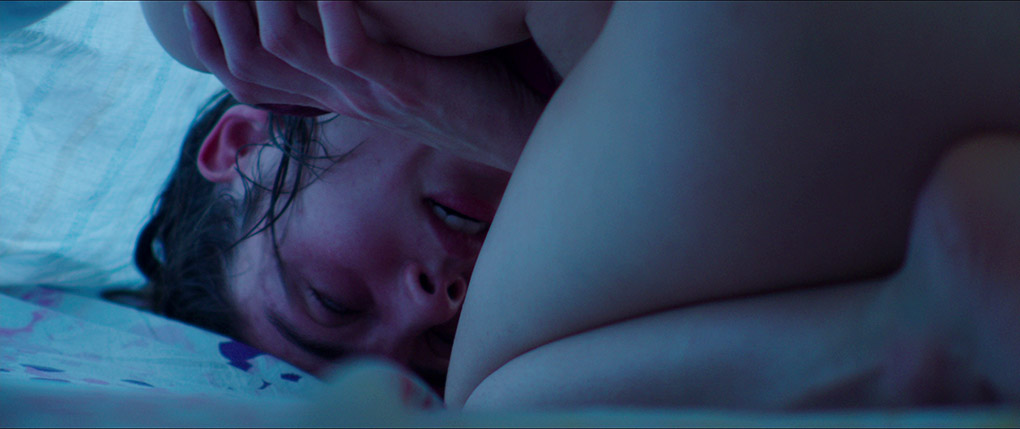
Here, cannibalism develops in the manner of a drug addiction, a first taste leading to a desire for more and eventually growing into a dangerous dependence, which at one point sees Justine strapped under her bedsheets and externalising her inner torment with all the physicality of a long-term addict who is desperate for a hit. In this respect, the film unfolds in the manner of a modern vampire tale and has elements in common with Katherine Bigelow’s Near Dark, a film in which a farm boy is bitten and then has to deal with a similar conflict between what his body needs and the morality of what he is told he has to do to feed. If the film has a sister work, however, it’s probably Marina de Van’s 2002 Dans ma peau [In My Skin], whose lead character (played by de Van) develops a desire to cut into her own flesh, one that peaks in an extraordinary and deeply uncomfortable scene in which cutting descends into hungry biting and chewing.
What really makes the film such compelling viewing, however, has as much to do with how this story unfolds as where it ultimately takes us. For a first-time feature director, Ducournau’s confidence and command of character and film storytelling is genuinely remarkable. From the start, she grounds the action in reality in her decision to film scenes inside a Belgian veterinary school and involve her characters with real animals and medical procedures, and when makeup effects are employed they are sometimes startling in the their realism. Ducournau’s own screenplay is impeccably structured, not just in how it moves the story forward but in how intricately so many of its elements are connected, much of which only becomes fully clear on a second viewing. Even seemingly throwaway character scenes always appear to have secondary purpose, with one in which a drunken Alex teaches Justine to pee standing up used both to cement the underlying bond between the two sisters (one that will be repeatedly tested during the course of the film) and continue in a similarly comedic manner, which assures that the considerable jolt that follows really catches us off guard. But it doesn’t end there. The aftermath of this shock moment moves Justine’s transformation forward a considerable step, which itself leads to revelation that changes how we must read much of what has gone before and subtly points the way to the extraordinary ending, one that casts the first third of the film in a completely new light.
The performances are unwaveringly terrific throughout. As Justine, Garance Marillier convinces completely as both an innocent freshman and the later flesh-hungry addict she becomes, the uncertain and wide-eyed glances she throws her sister when trying on a dress contrasting starkly with her almost demonic stare when biting down on her own arm in an attempt to control her hunger. It’s the truth of Marillier’s performance that so quickly pulled me in – I believed in and empathised with Justine as a person rather than a movie character from the off and thus felt for her at every turn of a story that is told almost completely from her perspective (only the pre-title teaser is not). Almost from the moment we first meet her, Ella Rumpf sells Alex as the rebellious black sheep to Justine’s academic over-achiever, one whose bond to her sister runs deep but that repeatedly conflicts with her impatience and willingness to humiliate her when the mood takes her. Completing the trio is Rabah Nait Oufella’s confident turn as Adrien, a likeable character around whom much of Justine’s development directly or indirectly revolves. Ducournau also understands the importance of having a top-notch supporting cast, casting even the smallest speaking roles with care and giving them a distinct personality and little bits of interesting business. Professional actors interact invisibly with real medical students, and perhaps the most memorable supporting role, that of the no-nonsense and cigarette-smoking nurse who treats Justine’s skin condition, is played not by an actor but respected writer-director Marion Vernoux.
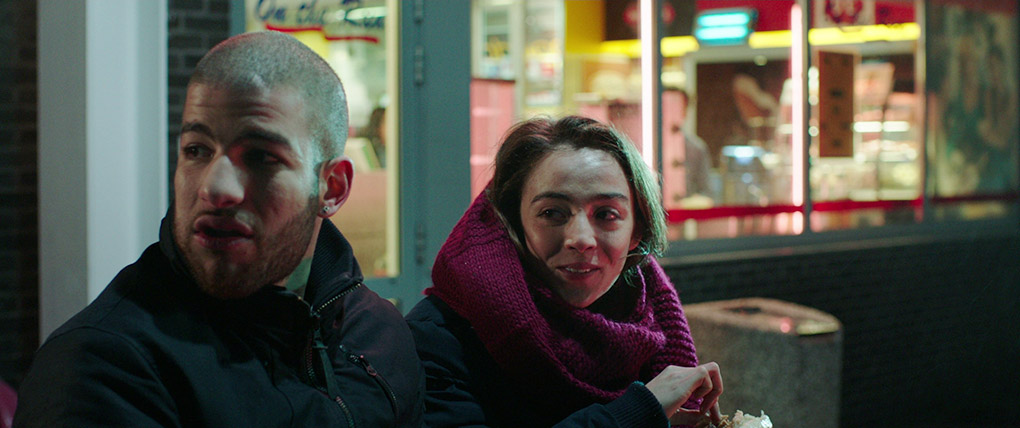
Ducournau directs with the confidence and technical skill of a veteran but the ambition and chance-taking vigour of a youthful newcomer. There’s no post-modernist winking at the audience here, which the acknowledged influences either given a quick nod – the blood-soaking hazing ritual visually references Carrie – or so seamlessly incorporated into the structure of the film that they don’t feel like influences at all. Cinematographer Ruben Impens creates a visually realistic foundation for a story in which colour still plays a prominent role, and the film has one of the best soundtracks I’ve heard in a long while, from the excellent sound design and foley work (when her skin rash prompts Justine to start feverishly scratching, I found myself wanting to do likewise) to an deliciously unsettling score by Jim Williams, a Ben Wheatley regular who also scored Brandon Cronenberg’s recent body-horror gem, Possessor. There’s also a particularly effective use of Plus putes que toutes les putes by Orties, a song whose lyrics alone should help to raise a few eyebrows but which feed into the subtext of the scene in which it plays. Crucially, Ducournau knows both how to quickly define characters and tell a compelling story, one so peppered with interconnected detail and subtext that it really does reward multiple viewings. Working simultaneously as a coming-of-age drama, a tale of sibling bonding and rivalry, a jarring body horror, a study of peer and family pressures and a metaphoric take on addiction, elements that intertwine so harmoniously and smartly that I’ve managed to get something new from every viewing. Raw is an absolute belter of a debut feature, and one of the smartest, most involving and thoughtfully realised body horror films this side of the Cronenberg family. I’m genuinely itching – no pun intended – so see what Ducournau does next.
Shot digitally on the Arri Alexa and framed 2.40:1, Raw looks as close to pristine here as you could hope, with crisply rendered detail and a nicely graded contrast balance that avoids highlight burn-outs and nails the black levels whilst keeping shadow detail clear. The colour palette leans towards the naturalistic, but brighter colours are vibrantly rendered, something particularly evident in the hazing scene in which the new students are soaked in brightly coloured paint. Being mastered from a digital original, there’s obviously not a blemish anywhere.
Fans of the film will probably be aware that it was previously released on Blu-ray in the UK by Universal, whose logo appears also at the front-end of the Second Sight disc, which seems to indicate that the transfer here was licenced from the Universal release. Comparing the two transfers side-by-side, the two do seem to be identical, boasting the same level of picture detail, contrast balance and colour rendition.
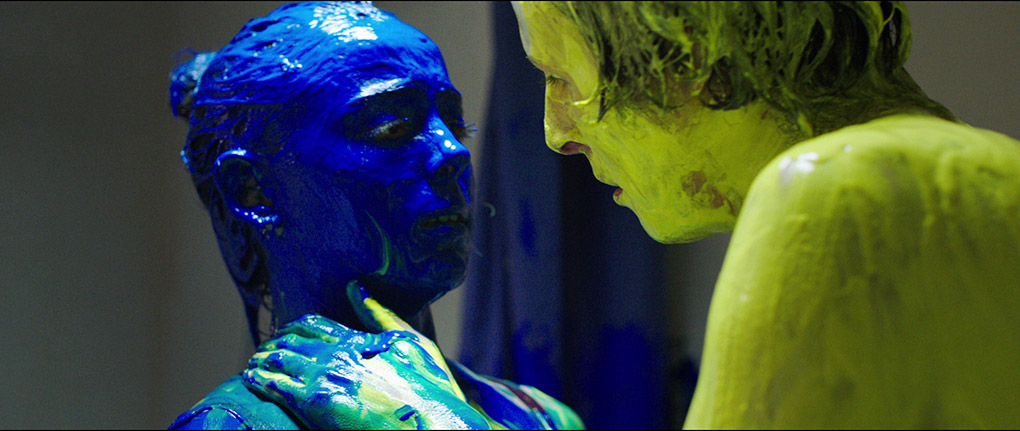
The Second Sight disc also retains the DTS-HD Master Audio 5.1 surround track from the Universal release, which boasts a lovely clarity, an ear-splitting dynamic range (the volume of the opening car crash really made me jump), and an excellent rendition of the sound effects and music, both of which play a crucial role here. A subtle use of the surround speakers for ambient sound in exterior scenes is detectable but is never exactly lively.
English subtitles appear by default but can be switched off if you prefer.
Oh yes, the main menu on the Second Sight Blu-ray is a lot more attractive than the purely functional one on the Universal disc, and the slip cover is way better.
Here’s where the Second Sight and Universal discs really part company. The Universal release was a film-only affair without a single special feature, whereas this new special edition from Second Sight is loaded with them. It’s quality material, though I will admit to being slightly thrown by the animated titles on many of the special features, which feel more suited to a Terminator-style science fiction movie than a drama-body horror crossover work. Okay, now I’ve had my tiny and insignificant quibble, let’s get down to business.
Audio Commentary with Julia Ducournau and Emma Westwood
Critic Emma Westwood plays host on a commentary on which she has almost as much to say as writer director Julian Ducournau, and while I wish Ducournau had been as close to the microphone as Westwood, this is still an excellent companion to the film and one from which I learned a great deal. Westwood asks pertinent questions here, and over the course of the commentary Ducournau reveals that the film is not about vegetarianism; that the sex scene was not difficult to shoot and was choreographed much like a stunt sequence; that the rabbit kidneys used in the hazing were made from jellified chocolate pudding and the raw chicken is tinted and moulded gummy bears; that a canteen discussion was influenced by the opening scene of Reservoir Dogs; that the hair vomiting scene (a deeply creepy and borderline supernatural sequence that I somehow failed to mention above) was inspired by cats and hairballs (“I really hate cats and think they’re gross”). She talks about the importance of sound design, the careful choreography of the early party sequence, the scene that was the most difficult to shoot, working with lead actor Garance Marillier on the under-the-sheet meltdown sequence, how the shooting process makes her feel so alive, and much more. By the end it becomes clear that the commentary is a few seconds out of sync with the image, but not enough to matter. Great stuff.
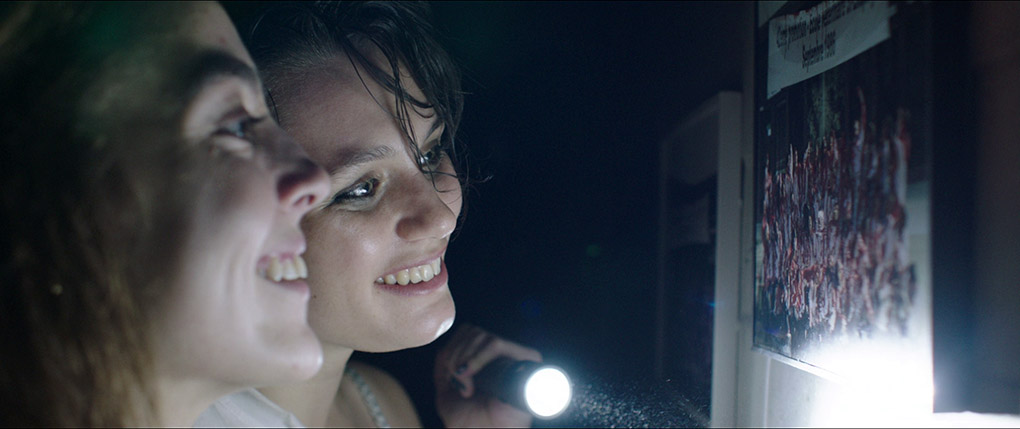
Audio Commentary by Alexandra West
Once again, this is how you do a second commentary right. Here, author of Films of the New French Extremity: Visceral Horror and National Identity, Alexandra West, avoids duplicating Ducournau’s comments in the previous commentary and brings a fresh and appreciative eye to the film, examining and sometimes deconstructing scenes in genuinely fascinating and enlightening detail. Areas covered include the film’s commentary on how people can feel outcast from societal places, how the treatment of the students during hazing can be linked to the mass production of meat, Justine’s character development and story arc, the portrayal of cannibalism in movies, the driving force for French Extremity Cinema, the importance of getting the practical effects and sound design just right, and plenty more. She has to turn away from the screen during the hair vomiting sequence, suggests that the two parents of this film are Clare Denis’ Trouble Every Day and Marina De Van’s Dans ma peau, and that Raw is an exciting child of the French Extremity. “I like this child,” she comments almost excitedly, “I would babysit this child.” Another excellent inclusion.
The Girl Can’t Help It: interview with Garance Marillier (15:04)
The film’s lead actor kicks off this interview by noting that her job gives her the chance to experience things she would otherwise not and that is why she is attracted to unusual rather than naturalistic tales. She recalls first meeting director Julia Ducournau, acting in her 2011 short film, Junior, and bonding with her over the years to the point when they are now like sisters. She talks about her first viewing of the finished film and the scene she most enjoyed shooting, discusses the French title and what she believes the film is about, and reveals that she gives all of the characters she plays an animal metaphor, which in the case of Raw was a panther. This is conducted in French with fixed English subtitles.
Making Ends Meat: interview with Jean des Forêts (15:00)
The film’s producer, Jean des Forêts, recalls the process of getting the film funded, how co-producer Julie Gayet convinced them to be more ambitious with their budget requirements and the difference this made, finding a veterinary school that they were able to shoot at, how the film eventually found its audience, and more. He acknowledges the possibly unconscious influence of Carrie, and reveals that the film was hugely successful in Mexico and that temp tracking the film with Jim Williams music ultimately led to him composing the score. Again, this is conducted in French with English subtitles.
In the Name of Raw: interview with Julia Ducournau (48:36)
One concern I had when I first catalogued the special features on this disc was that the number of special features involving director Julia Ducournau made it likely that there would be quite a bit of repetition, and I thus approached this 48-minute interview expecting to hear several of the same questions asked and stories told as in the commentary. Not a bit of it. In this interview conducted by Fausto Fasulo of Mad Movies, there’s almost no overlap with either of the commentaries, as Ducournau talks in detail about the evolution of the screenplay and the lead characters, her approach to visualising her words, the importance of sound in genre movies, casting Garance Marillier and working with her on the under-the-sheet sequence, avoiding fluctuations in tone when mixing horror and character comedy, cannibalism as the ultimate taboo, approaching Jim Williams to do the score, and more. She specifies that she wanted the film to have a realistic look and references Cronenberg’s The Fly as a film that achieves this, explains how losing one aspect of the story would destroy its balance, and makes clear that this is less a film about a girl becoming a woman than one about a girl who becomes a human being. A really useful inclusion, which is once again in French with fixed English subtitles.
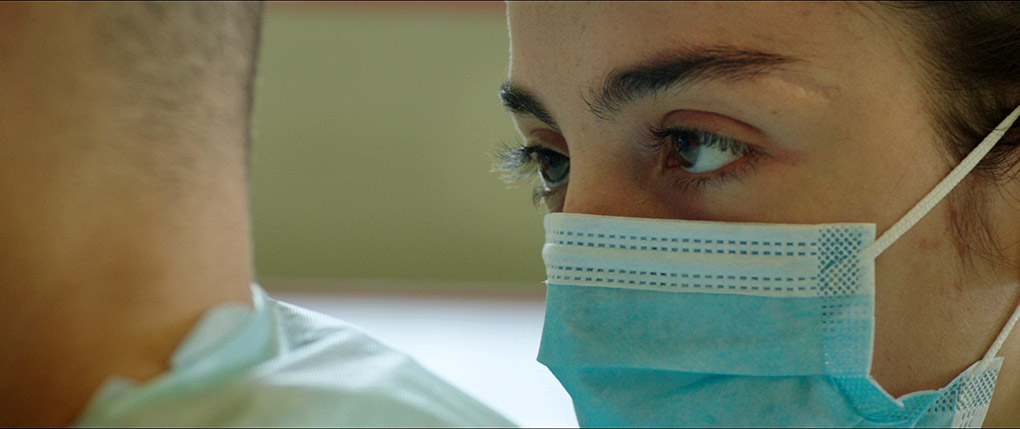
A Family Affair: video essay by Alexandra Heller-Nicholas (12:45)
An insightful examination of some of the key themes of the film by author and critic Alexandra Heller-Nicholas, but one I can’t really detail without getting into spoiler territory, which this essay does in spades, so make sure not to watch this before seeing the film for the first time.
Raw À Votre Goût: with Julia Docournau & Emma Westwood (13:53)
Author and film critic Emma Westwood, who also acts as host on the first commentary track, here asks a few questions of director Julia Docournau, and I’d probably be suggesting this would be safe to watch as an introduction to the film had the clips used to pad it out not included some serious spoilers, including how the film ends. Here Docournau talks about her journey from film school to writing and directing Raw, working with Garance Marillier on Junior and finally casting her as Justine when she was old enough to play the part, what she hopes an audience will take from the movie, and the influence of David Cronenberg on her approach. A little glum visually, the interview is conducted in English, although the clarity is impacted just a tad by room acoustics and the annoying decision to have music playing throughout.
Quick Bites: with Julia Docournau & Alexandra Heller-Nicholas (3:00)
Director Julia Docournau talks to author and critic Alexandra Heller-Nicholas about audience reactions, the use of mobile phone cameras by characters in the film (“a disease of our times”), and the influence of Tobe Hooper’s The Texas Chainsaw Massacre.
Genre Matters Discussion Panel (57:05)
A video record of a panel discussion at the 2016 Monster Fest in Australia titled Women Genre Filmmakers that is chaired by festival director and filmmaker Briony Kidd, whose short films include The Room at the Top of the Stairs (2010) and Watch Me (2016). Talking about their work and experiences are filmmakers Marisa Brown (Waterborne, 2014), Heidi Lee Douglas (Little Lamb, 2014), Mattie Do (Dearest Sister, 2016), Donna McRae (Johnny Ghost, 2011), Isabel Peppard (Butterflies, 2012) and, of course, Julia Docournau. Topics under discussion include the positive aspects of working in the horror genre and the freedom it gives you to explore any topic and let your imagination run free, the recurring themes in each of their films, problems that they face in the production and financing of their work, and the one change they would like to see the industry make to help support them and what they want to do. When Docournau gets to speak she’s always worth hearing, notably when she dismisses the very notion of French Extremity Cinema by claiming there’s no such thing (best not mention that to Films of the New French Extremity: Visceral Horror and National Identity author Alexandra West) and that it was just “seven movies made over twenty years.” Even more memorable is her angry parting shot, “I can’t stand the expression ‘woman director’ anymore. I’m a fucking director! Martin Scorsese is not a ‘man director’!”
Australian Premiere Introduction (5:34)
Effectively a primer for the extra that follows, with Julia Docournau giving a quick talk to the audience before the Australian premiere screening of Raw at the 2016 Monster Fest after being introduced by festival director Kier-La Janisse. My favourite moment has Docournau impressed that audience members are allowed to bring the booze they bought at the bar into the screening.
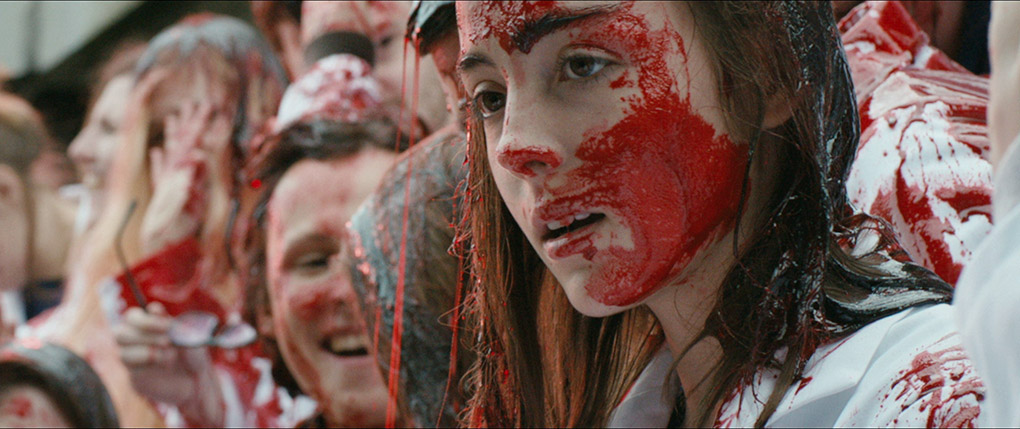
Australian Premiere Q&A (42:00)
Kier-La Janisse and Julia Docournau return to the stage after the screening of the film to discuss a few points before opening things up for questions from a very appreciative audience. Here Docournau talks about Justine’s story arc, how a discourse on cannibalism can actually be about humanity, the casting of the two sisters, shooting in a Belgian veterinary school, and more. She also confirms that she’s a big horror buff, that David Cronenberg is one of her idols and that The Fly is one of her favourite films. There is some minor crossover with other extras, but there’s still plenty here that’s new or is approached from a different perspective, and the various responses from audience members are noteworthy.
Deleted Scenes (4:39)
Two deleted scenes have been included here, both with optional English subtitles. The first is a trippy expansion of the lecture that Justine arrives late to, after which she runs down a corridor in slow motion and vomits over a window. The second is a new sequence in which Adrien arrives home dead drunk and collapses on the floor, and Justine, her face covered in white skin cream, struggles to help him up and plonk him on his bed. The look she gives him when he passes out is intriguing, and she follows this by licking his face and taking comfort in his arms.
Also included with the release is a perfect-bound booklet with new essays by Hannah Woodhead and Emma Westwood and an interview with Julia Ducournau by Lou Thomas, plus three collectors’ art carts, but these were not available for review.
One of my favourite films from 2017 and one of the best body horror works in years here gets the release it so richly deserves. Even if you have the Universal Blu-ray, this is an absolute must-have for its improved 5.1 soundtrack and the plethora of excellent special features that accompany the film. Another terrific special edition release from Second Sight gets our highest recommendation.
|